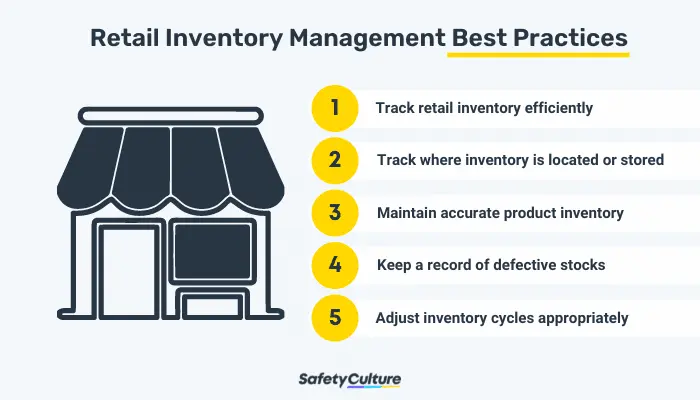What is Retail Inventory Management?
Retail inventory management is the systematic technique a business implements to ensure that there is enough product stock in store, and in other retail chain areas such as a warehouse, to meet customer demand.
Importance of Inventory Management in Retail
Retail managers know the pain of having insufficient inventory in store, the waiting time for reordering stocks, and the possibility of product spoilage and loss. This is why integrating the right retail inventory management process is important to achieving smooth retail operations.
Retailers that handle perishable inventory will need to take extra steps. For example, when a retailer, such as a grocery store, is caught selling an expired product, they’ll have to pay a fine and face legal and compliance issues. This will also have a detrimental effect on the business’ image and reputation. Retailers that stock perishable goods can utilize accessories to monitor product quality and quantity. SafetyCulture Sensors can retrieve real-time data on temperature, humidity, gasses and air particles present, air pressure, and other factors in the area where retail goods are stored.
A good retail inventory management system will save your business from poor retail performance and extra costs.
Difference Between Retail Inventory Management and Other Types of Inventory Management
The difference between retail inventory management with other inventory management systems is that the scope of the prior does not include wholesale inventory and other areas of the supply chain.
Essentially, retail management starts with having a physical inventory of the products. These stocks can be located in the warehouse or in stores. As warehouses are often utilized by larger businesses, a common challenge faced when using warehouses is that it can lead to stock inaccuracy and lack of visibility if there is no proper communication between the retail store managers and warehouse managers. Retailers can employ warehouse inventory management to create an overall effective retail inventory management system and process.
How Often Do Stores Take Inventory?
Retailers should track inventory as often as they can. This can be troublesome if the system is not only manual but also conducted on paper. Problems such as inaccurate inventory and product waste or loss can occur when inventory is not constantly and timely checked. One of the best ways a retailer can avoid these is to implement a digital retail inventory management system that can track real-time data on the inventory’s quantity and quality.
Digital inventory management tools usually work on computers but more modern technology for inventory management allows the use of mobile devices such as phones and tablets that are easier to carry and less likely to get lost or damaged (compared to paper) during an in-store inventory check. Another advantage of using a digital inventory tool is that media files can be uploaded and data is automatically available on the retailer’s inventory management system.
Digitize the way you Work
Empower your team with SafetyCulture to perform checks, train staff, report issues, and automate tasks with our digital platform.
Get Started for FreeBest Practices
Stay ahead of potential low retail inventory by following these best management practices:
- Track retail inventory efficiently – This can be done by using a digital inventory checklist tool to ensure all areas of inventory are covered. The retail inventory checklist can track store items and their quantity, record labels, product SKU, images of the product, etc. Users can customize the inventory checklist to fit their needs.
- Track where inventory is located or stored – Improve retail visibility by tracking where an item is located in the store and also in a warehouse. This saves time in retrieving the product for a customer and also replenishing product stocks for store shelves. Warehouse managers would be able to fulfill reorder requests from the retail store in a timely manner.
- Maintain accurate product inventory – Employees would be able to use their time on other store tasks instead of retrieving and putting back inventory due to inaccurate store inventory. One way this can be done is for retail managers to install tools such as cameras to see the store in all areas and be able to convey to the employees when to restock the shelves. Another tool to accurately track product stock is employing a digital retail inventory management system.
- Keep a record of defective stocks – Defective products are a loss. Track defective items by using a retail audit to not only record but also check whether there is a trend in the data that can be used to improve retail inventory processes and lessen product defects and spoilage.
- Adjust inventory cycles appropriately – Overstocking can cost store space and also lead to product waste and loss. As time goes on, the retail manager should be able to create better inventory decisions to prevent overstocking products in the store. One of these inventory decisions is deciding when to replenish inventory. If the retail manager was able to do the previous 4 tips, they should have enough data to ensure that the store has enough inventory.
Introduction to SafetyCulture
Retailers know the pain of a manual inventory management system. It’s time to take advantage of simple but intuitive digital tools such as SafetyCulture (formerly iAuditor). This app can come with smart sensors perfect for retailers that sell perishable goods such as grocery, pharmacy, and convenience stores.
Coles, the Australian supermarket, utilizes SafetyCulture to conduct efficient processes such as retail audits and inspections. The business was able to use data insights for transparency in the entire corporation as well as to identify trends that can point to opportunities for improvement. The retail system has improved so much that today, this app has been rolled out across 760 Coles branches.
SafetyCulture as a Retail Inventory Management Software
Streamline retail inventory management processes and empower your employees to provide high-quality products today with SafetyCulture (formerly iAuditor). Get visibility in your retail businesses along with these features:
- Perform real-time data collection that is cloud synced automatically;
- Monitor daily retail operations including inventory, cleanliness, and safety;
- Take pictures of the merchandise and take note of defects;
- Assign corrective actions for non-compliance;
- Generate comprehensive and real-time reports on your mobile and share them with your organization;
- Schedule and assign your retail inventory audits and inspections easily; and
- Monitor trends and frequently failed items via the Analytics dashboard of the SafetyCulture Retail Inventory Management Software.
How SafetyCulture helped Coles with their retail inventory management
“SafetyCulture empowers us to give the customers a shop that they can trust, and gives us the ease and simplicity to let stores really get ahead of the game to deliver on opportunities to improve.” — Simon McBurney, Senior Delivery Analyst with Coles




